Falklands Island Photo Tour
November 26-December 12, 2021
Price: $8,195, SS: $$700
6 participants
contact office for information
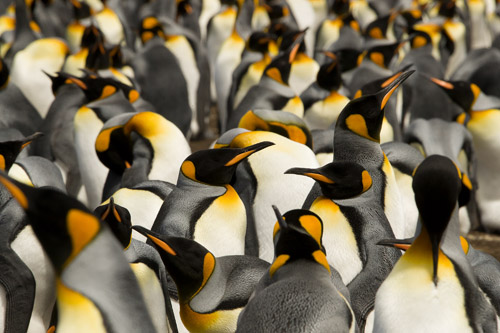
King Penguins at Volunteer Point, one of the five species
we will be photographing in the Falklands
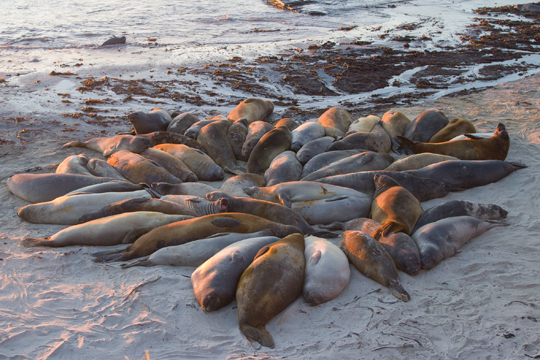
A strange pre-dawn gathering of Southern Elephant Seals
on Sea Lion Island - there is always new and unusual behavior to record!
We love the Falklands, and consider it one of the best locations in the world for bird photography. Five species of penguins, many species of song birds, water birds, and birds of prey, and all are approachable and easy to shoot.
For a great idea of what you can expect, read our 2017 Trip Report, 2016 Trip Report,
or our 2013 Trip Report for the Falklands.
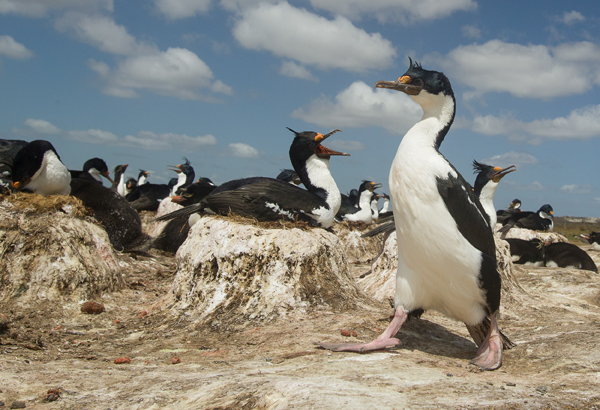
With our small group size, and unhurried visits to great sites you'll have the opportunity
to photograph intimate views with unique perspectives.
Group size is limited to 6 photographers, with two leaders, Mary and Joe.
Five species of Penguins - more than you could see on an Antarctic trip!
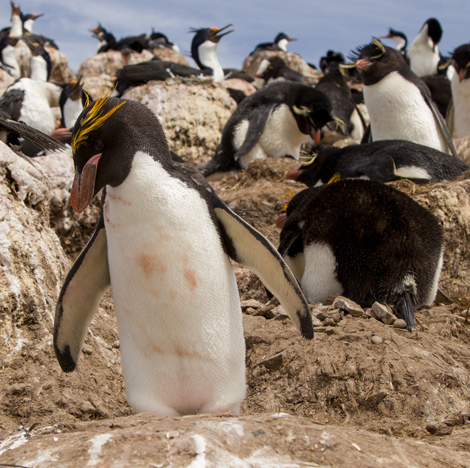
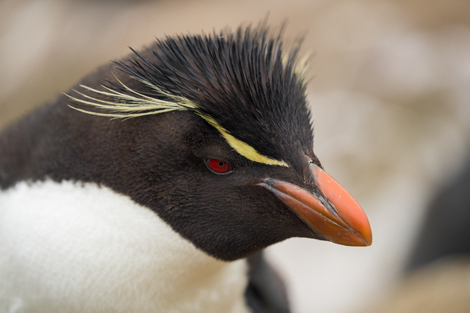
Macaroni, left; Rock-hopper, right
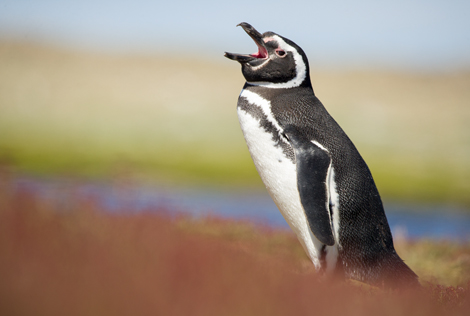
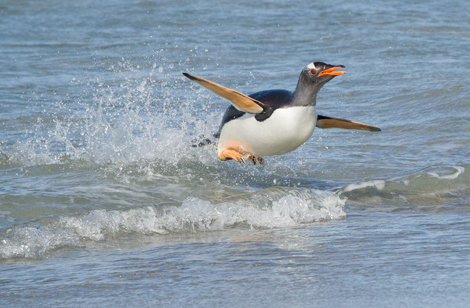
Magellanic, left; Gentoo, right
The Galapagos of the South Atlantic
The Falkland Islands have been rightly compared to the iconic Galapagos, but in many ways the Falklands are an even more exciting location for photography. If you have visited the Falklands on a cruise, you have only scratched the surface. A LAND-BASED trip offers so much more, and we believe the shooting is far more productive and rewarding than a trip to South Georgia or Antarctica. Granted, the Falklands does not have the grand scenery of those two locations, but it has a great diversity of wildlife. And, unlike a cruise, being land-based, and flying from one island to another, our trip's success is not dependent upon the weather. On a ship, if there are storms or high winds, you may not be able to land for any destination, but on a land-based trip, if the weather is poor and the planes don't fly, you stay on the island you're on, and you can keep photographing! That, to us, is the best thing about the Falklands.
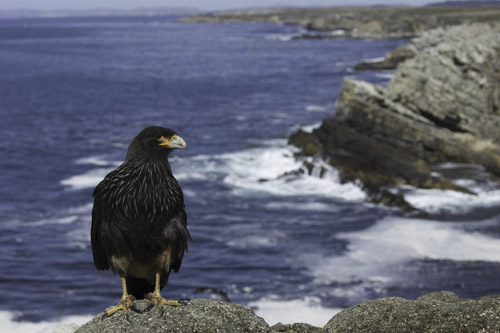
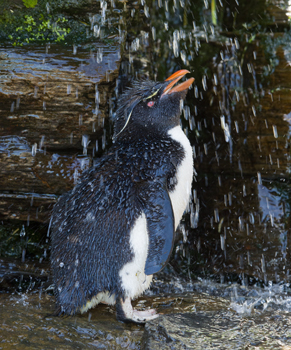
Striated Caracaras are one of the 'top predators' on the islands. At one of our locations, there is a 'shower' where
Rock-hopper Penguins returning to the sea bathe before continuing uphill to their nesting site.
Comparing the Falklands to the Galapagos, again, the Falklands offer a tremendous advantage. In the Galapagos you are accompanied by a guide and your island visits are restricted to the beaches and to designated trails, and sometimes to a specific schedule for a trail walk. In the Falklands, we're free to wander wherever we wish, and our access is limited only to common sense and our concern to not disturb the wildlife. Wide-angle photography is common, and the largest lens we carry is a 100-400mm zoom!
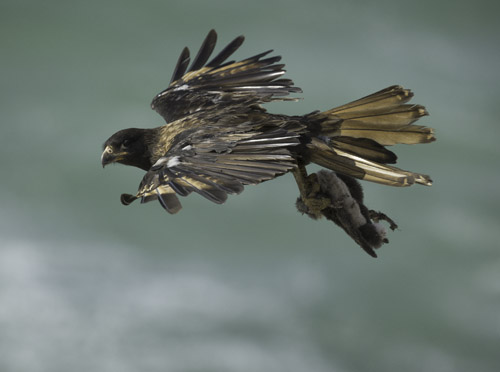 We've been travelling to the Falklands for nearly thirty years, and we know, and our friends with, many of the island owners, the drivers, and the various staffs. To us, the Falklands are like home, and we hope you'll join us on this incredible trip.
We've been travelling to the Falklands for nearly thirty years, and we know, and our friends with, many of the island owners, the drivers, and the various staffs. To us, the Falklands are like home, and we hope you'll join us on this incredible trip.
Our Itinerary during our 2019 (cancelled) and 2020 tours differ.
For both, we'll be visiting the top photography sites that are appropriate for the season. Which one you choose depends upon what you're most interested in seeing, although I must stress that the subjects will be virtually identical for both, but behavior, family life, chick size, etc. will differ.
On the December trip (cancelled) Penguins will either be sitting on eggs or hatching small chicks. Black-browed Albatrosses will be sitting on eggs, although some eggs will be hatching and small chicks may be visible. Elephant Seal pups are weaned, and may be going to sea, attracting Orcas, or Killer Whales. Songbirds and many shorebirds will be nesting, and most ducks and geese will be raising young.
On the January trip Penguins will be raising chicks. Albatross chicks will be common, with plenty of feeding activity. Most shorebirds and songbirds should be feeding or raising young. Orcas may be hunting Gentoos heading to or from the sea.
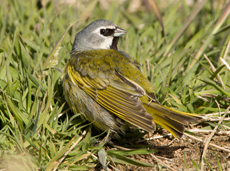
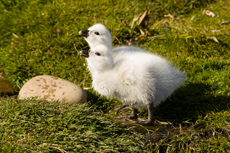
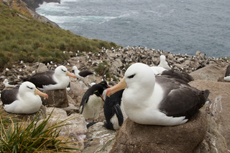
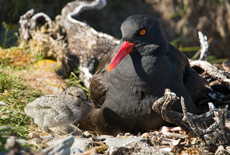
From left to right: Black-chinned Siskin; Kelp Goose chicks; Black-browed Albatross colony; Black Oystercatcher
.
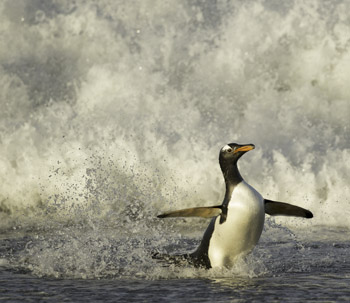
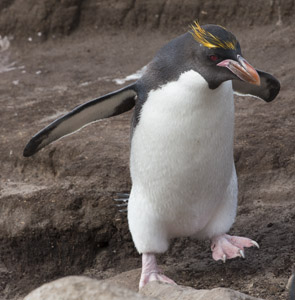
Gentoo surfing in; Macaroni hopping its way to the nest.
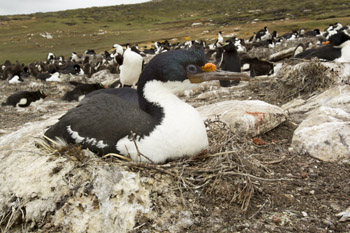
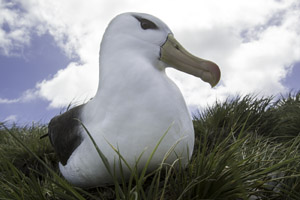
KingCormorant colony; Black-browed Albatross after landing on a tussock above me!
Falklands Island Photo Tour
November 26-December 12, 2021
Price: $8,195, SS: $$700
6 participants
contact office for information

King Penguins at Volunteer Point, one of the five species
we will be photographing in the Falklands

A strange pre-dawn gathering of Southern Elephant Seals
on Sea Lion Island - there is always new and unusual behavior to record!
We love the Falklands, and consider it one of the best locations in the world for bird photography. Five species of penguins, many species of song birds, water birds, and birds of prey, and all are approachable and easy to shoot.
For a great idea of what you can expect, read our 2017 Trip Report, 2016 Trip Report,
or our 2013 Trip Report for the Falklands.

With our small group size, and unhurried visits to great sites you'll have the opportunity
to photograph intimate views with unique perspectives.
Group size is limited to 6 photographers, with two leaders, Mary and Joe.
Five species of Penguins - more than you could see on an Antarctic trip!


Macaroni, left; Rock-hopper, right


Magellanic, left; Gentoo, right
The Galapagos of the South Atlantic
The Falkland Islands have been rightly compared to the iconic Galapagos, but in many ways the Falklands are an even more exciting location for photography. If you have visited the Falklands on a cruise, you have only scratched the surface. A LAND-BASED trip offers so much more, and we believe the shooting is far more productive and rewarding than a trip to South Georgia or Antarctica. Granted, the Falklands does not have the grand scenery of those two locations, but it has a great diversity of wildlife. And, unlike a cruise, being land-based, and flying from one island to another, our trip's success is not dependent upon the weather. On a ship, if there are storms or high winds, you may not be able to land for any destination, but on a land-based trip, if the weather is poor and the planes don't fly, you stay on the island you're on, and you can keep photographing! That, to us, is the best thing about the Falklands.


Striated Caracaras are one of the 'top predators' on the islands. At one of our locations, there is a 'shower' where
Rock-hopper Penguins returning to the sea bathe before continuing uphill to their nesting site.
Comparing the Falklands to the Galapagos, again, the Falklands offer a tremendous advantage. In the Galapagos you are accompanied by a guide and your island visits are restricted to the beaches and to designated trails, and sometimes to a specific schedule for a trail walk. In the Falklands, we're free to wander wherever we wish, and our access is limited only to common sense and our concern to not disturb the wildlife. Wide-angle photography is common, and the largest lens we carry is a 100-400mm zoom!
 We've been travelling to the Falklands for nearly thirty years, and we know, and our friends with, many of the island owners, the drivers, and the various staffs. To us, the Falklands are like home, and we hope you'll join us on this incredible trip.
We've been travelling to the Falklands for nearly thirty years, and we know, and our friends with, many of the island owners, the drivers, and the various staffs. To us, the Falklands are like home, and we hope you'll join us on this incredible trip.
Our Itinerary during our 2019 (cancelled) and 2020 tours differ.
For both, we'll be visiting the top photography sites that are appropriate for the season. Which one you choose depends upon what you're most interested in seeing, although I must stress that the subjects will be virtually identical for both, but behavior, family life, chick size, etc. will differ.
On the December trip (cancelled) Penguins will either be sitting on eggs or hatching small chicks. Black-browed Albatrosses will be sitting on eggs, although some eggs will be hatching and small chicks may be visible. Elephant Seal pups are weaned, and may be going to sea, attracting Orcas, or Killer Whales. Songbirds and many shorebirds will be nesting, and most ducks and geese will be raising young.
On the January trip Penguins will be raising chicks. Albatross chicks will be common, with plenty of feeding activity. Most shorebirds and songbirds should be feeding or raising young. Orcas may be hunting Gentoos heading to or from the sea.




From left to right: Black-chinned Siskin; Kelp Goose chicks; Black-browed Albatross colony; Black Oystercatcher
.


Gentoo surfing in; Macaroni hopping its way to the nest.


KingCormorant colony; Black-browed Albatross after landing on a tussock above me!
Falklands Island Photo Tour
November 26-December 12, 2021
Price: $8,195, SS: $$700
6 participants
contact office for information

King Penguins at Volunteer Point, one of the five species
we will be photographing in the Falklands

A strange pre-dawn gathering of Southern Elephant Seals
on Sea Lion Island - there is always new and unusual behavior to record!
We love the Falklands, and consider it one of the best locations in the world for bird photography. Five species of penguins, many species of song birds, water birds, and birds of prey, and all are approachable and easy to shoot.
For a great idea of what you can expect, read our 2017 Trip Report, 2016 Trip Report,
or our 2013 Trip Report for the Falklands.

With our small group size, and unhurried visits to great sites you'll have the opportunity
to photograph intimate views with unique perspectives.
Group size is limited to 6 photographers, with two leaders, Mary and Joe.
Five species of Penguins - more than you could see on an Antarctic trip!


Macaroni, left; Rock-hopper, right


Magellanic, left; Gentoo, right
The Galapagos of the South Atlantic
The Falkland Islands have been rightly compared to the iconic Galapagos, but in many ways the Falklands are an even more exciting location for photography. If you have visited the Falklands on a cruise, you have only scratched the surface. A LAND-BASED trip offers so much more, and we believe the shooting is far more productive and rewarding than a trip to South Georgia or Antarctica. Granted, the Falklands does not have the grand scenery of those two locations, but it has a great diversity of wildlife. And, unlike a cruise, being land-based, and flying from one island to another, our trip's success is not dependent upon the weather. On a ship, if there are storms or high winds, you may not be able to land for any destination, but on a land-based trip, if the weather is poor and the planes don't fly, you stay on the island you're on, and you can keep photographing! That, to us, is the best thing about the Falklands.


Striated Caracaras are one of the 'top predators' on the islands. At one of our locations, there is a 'shower' where
Rock-hopper Penguins returning to the sea bathe before continuing uphill to their nesting site.
Comparing the Falklands to the Galapagos, again, the Falklands offer a tremendous advantage. In the Galapagos you are accompanied by a guide and your island visits are restricted to the beaches and to designated trails, and sometimes to a specific schedule for a trail walk. In the Falklands, we're free to wander wherever we wish, and our access is limited only to common sense and our concern to not disturb the wildlife. Wide-angle photography is common, and the largest lens we carry is a 100-400mm zoom!
 We've been travelling to the Falklands for nearly thirty years, and we know, and our friends with, many of the island owners, the drivers, and the various staffs. To us, the Falklands are like home, and we hope you'll join us on this incredible trip.
We've been travelling to the Falklands for nearly thirty years, and we know, and our friends with, many of the island owners, the drivers, and the various staffs. To us, the Falklands are like home, and we hope you'll join us on this incredible trip.
Our Itinerary during our 2019 (cancelled) and 2020 tours differ.
For both, we'll be visiting the top photography sites that are appropriate for the season. Which one you choose depends upon what you're most interested in seeing, although I must stress that the subjects will be virtually identical for both, but behavior, family life, chick size, etc. will differ.
On the December trip (cancelled) Penguins will either be sitting on eggs or hatching small chicks. Black-browed Albatrosses will be sitting on eggs, although some eggs will be hatching and small chicks may be visible. Elephant Seal pups are weaned, and may be going to sea, attracting Orcas, or Killer Whales. Songbirds and many shorebirds will be nesting, and most ducks and geese will be raising young.
On the January trip Penguins will be raising chicks. Albatross chicks will be common, with plenty of feeding activity. Most shorebirds and songbirds should be feeding or raising young. Orcas may be hunting Gentoos heading to or from the sea.




From left to right: Black-chinned Siskin; Kelp Goose chicks; Black-browed Albatross colony; Black Oystercatcher
.


Gentoo surfing in; Macaroni hopping its way to the nest.
Falklands Island Photo Tour
November 26-December 12, 2021
Price: $8,195, SS: $$700
6 participants
contact office for information

King Penguins at Volunteer Point, one of the five species
we will be photographing in the Falklands

A strange pre-dawn gathering of Southern Elephant Seals
on Sea Lion Island - there is always new and unusual behavior to record!
We love the Falklands, and consider it one of the best locations in the world for bird photography. Five species of penguins, many species of song birds, water birds, and birds of prey, and all are approachable and easy to shoot.
For a great idea of what you can expect, read our 2017 Trip Report, 2016 Trip Report,
or our 2013 Trip Report for the Falklands.

With our small group size, and unhurried visits to great sites you'll have the opportunity
to photograph intimate views with unique perspectives.
Group size is limited to 6 photographers, with two leaders, Mary and Joe.
Five species of Penguins - more than you could see on an Antarctic trip!


Macaroni, left; Rock-hopper, right


Magellanic, left; Gentoo, right
The Galapagos of the South Atlantic
The Falkland Islands have been rightly compared to the iconic Galapagos, but in many ways the Falklands are an even more exciting location for photography. If you have visited the Falklands on a cruise, you have only scratched the surface. A LAND-BASED trip offers so much more, and we believe the shooting is far more productive and rewarding than a trip to South Georgia or Antarctica. Granted, the Falklands does not have the grand scenery of those two locations, but it has a great diversity of wildlife. And, unlike a cruise, being land-based, and flying from one island to another, our trip's success is not dependent upon the weather. On a ship, if there are storms or high winds, you may not be able to land for any destination, but on a land-based trip, if the weather is poor and the planes don't fly, you stay on the island you're on, and you can keep photographing! That, to us, is the best thing about the Falklands.


Striated Caracaras are one of the 'top predators' on the islands. At one of our locations, there is a 'shower' where
Rock-hopper Penguins returning to the sea bathe before continuing uphill to their nesting site.
Comparing the Falklands to the Galapagos, again, the Falklands offer a tremendous advantage. In the Galapagos you are accompanied by a guide and your island visits are restricted to the beaches and to designated trails, and sometimes to a specific schedule for a trail walk. In the Falklands, we're free to wander wherever we wish, and our access is limited only to common sense and our concern to not disturb the wildlife. Wide-angle photography is common, and the largest lens we carry is a 100-400mm zoom!
 We've been travelling to the Falklands for nearly thirty years, and we know, and our friends with, many of the island owners, the drivers, and the various staffs. To us, the Falklands are like home, and we hope you'll join us on this incredible trip.
We've been travelling to the Falklands for nearly thirty years, and we know, and our friends with, many of the island owners, the drivers, and the various staffs. To us, the Falklands are like home, and we hope you'll join us on this incredible trip.
Our Itinerary during our 2019 (cancelled) and 2020 tours differ.
For both, we'll be visiting the top photography sites that are appropriate for the season. Which one you choose depends upon what you're most interested in seeing, although I must stress that the subjects will be virtually identical for both, but behavior, family life, chick size, etc. will differ.
On the December trip (cancelled) Penguins will either be sitting on eggs or hatching small chicks. Black-browed Albatrosses will be sitting on eggs, although some eggs will be hatching and small chicks may be visible. Elephant Seal pups are weaned, and may be going to sea, attracting Orcas, or Killer Whales. Songbirds and many shorebirds will be nesting, and most ducks and geese will be raising young.
On the January trip Penguins will be raising chicks. Albatross chicks will be common, with plenty of feeding activity. Most shorebirds and songbirds should be feeding or raising young. Orcas may be hunting Gentoos heading to or from the sea.




From left to right: Black-chinned Siskin; Kelp Goose chicks; Black-browed Albatross colony; Black Oystercatcher
.


Gentoo surfing in; Macaroni hopping its way to the nest.


KingCormorant colony; Black-browed Albatross after landing on a tussock above me!

The King Penguin colony at Volunteer Point
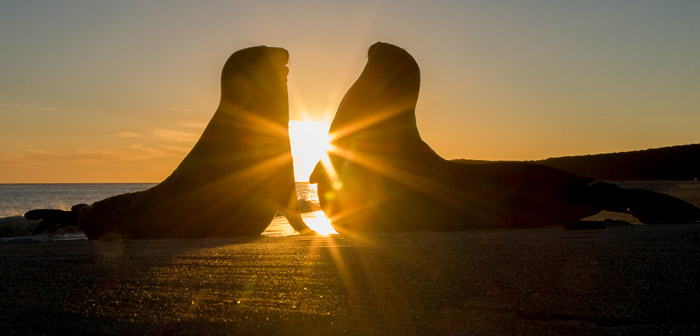
Two young Elephant Seals square off at sunset at Sea Lion Island
Please contact our office
About Your Leaders
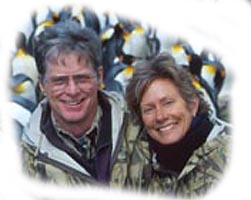
My wife Mary Ann and I strive to provide the most comfortable and
thorough photo tour you will experience. Read Testimonials. Both Mary and I are professional photographers, and
I'd hope you've seen our credits. These included
National Geographic, National Wildlife, Ranger Rick, Natural History,
Living Bird, Birder's World, and most nature/wildlife calendars.
As a husband/wife team, Mary Ann and I have won more times in the
prestigious BBC Wildlife Photographer of the Year competition than any
one. To date we have had 15 firsts, seconds, or thirds -- and we have
not entered every year. Our trips are not about us, however, they are all
for you, but credentials seem to matter, and we have them.
Mary has written twenty-nine (29) children's books, including Leopards, Grizzly Bears, Woodpeckers,
Flying Squirrels, Sunflowers, Cobras, Jupiter, Boas, Garter Snakes, Pythons, Rattlesnakes, Ducks, Chickens, Horses, and Cows, and a coffee table book, Out of the Past, Amish Tradition and Faith.
I've written several how-to wildlife photography books -- A Practical Guide to Photographing American Wildlife,
The Wildlife Photographer's Field Manual, The Complete Guide to Wildlife Photography, Designing Wildlife
Photographs, Photographing on Safari, A Field Guide to Photographing in East Africa, and the New Complete
Guide to Wildlife Photography, African Wildlife, Creatures of the Night, The World's Deadliest, and several
ebooks. We have produced an instructional video, A Video Guide to Photographing on Safari with
Joe and Mary Ann McDonald.
We are both editors for Nature Photographer magazine.
In addition to leading our trips to Tanzania, Mary and I personally lead photo safaris to Kenya,
Brazil's Pantanal, Chile, Galapagos, Svalbard, India, Alaska, Rwanda, Yellowstone, Ecuador, Costa Rica,
the Falklands, Antarctica, South Texas, Arizona, and some other spots, too!

The King Penguin colony at Volunteer Point

Two young Elephant Seals square off at sunset at Sea Lion Island
Please contact our office
About Your Leaders

My wife Mary Ann and I strive to provide the most comfortable and
thorough photo tour you will experience. Read Testimonials. Both Mary and I are professional photographers, and
I'd hope you've seen our credits. These included
National Geographic, National Wildlife, Ranger Rick, Natural History,
Living Bird, Birder's World, and most nature/wildlife calendars.
As a husband/wife team, Mary Ann and I have won more times in the
prestigious BBC Wildlife Photographer of the Year competition than any
one. To date we have had 15 firsts, seconds, or thirds -- and we have
not entered every year. Our trips are not about us, however, they are all
for you, but credentials seem to matter, and we have them.
Mary has written twenty-nine (29) children's books, including Leopards, Grizzly Bears, Woodpeckers,
Flying Squirrels, Sunflowers, Cobras, Jupiter, Boas, Garter Snakes, Pythons, Rattlesnakes, Ducks, Chickens, Horses, and Cows, and a coffee table book, Out of the Past, Amish Tradition and Faith.
I've written several how-to wildlife photography books -- A Practical Guide to Photographing American Wildlife,
The Wildlife Photographer's Field Manual, The Complete Guide to Wildlife Photography, Designing Wildlife
Photographs, Photographing on Safari, A Field Guide to Photographing in East Africa, and the New Complete
Guide to Wildlife Photography, African Wildlife, Creatures of the Night, The World's Deadliest, and several
ebooks. We have produced an instructional video, A Video Guide to Photographing on Safari with
Joe and Mary Ann McDonald.
We are both editors for Nature Photographer magazine.
In addition to leading our trips to Tanzania, Mary and I personally lead photo safaris to Kenya,
Brazil's Pantanal, Chile, Galapagos, Svalbard, India, Alaska, Rwanda, Yellowstone, Ecuador, Costa Rica,
the Falklands, Antarctica, South Texas, Arizona, and some other spots, too!

The King Penguin colony at Volunteer Point

Two young Elephant Seals square off at sunset at Sea Lion Island
Please contact our office
About Your Leaders
The King Penguin colony at Volunteer Point

Two young Elephant Seals square off at sunset at Sea Lion Island
Please contact our office

My wife Mary Ann and I strive to provide the most comfortable and
thorough photo tour you will experience. Read Testimonials. Both Mary and I are professional photographers, and
I'd hope you've seen our credits. These included
National Geographic, National Wildlife, Ranger Rick, Natural History,
Living Bird, Birder's World, and most nature/wildlife calendars.
As a husband/wife team, Mary Ann and I have won more times in the
prestigious BBC Wildlife Photographer of the Year competition than any
one. To date we have had 15 firsts, seconds, or thirds -- and we have
not entered every year. Our trips are not about us, however, they are all
for you, but credentials seem to matter, and we have them.
Mary has written twenty-nine (29) children's books, including Leopards, Grizzly Bears, Woodpeckers,
Flying Squirrels, Sunflowers, Cobras, Jupiter, Boas, Garter Snakes, Pythons, Rattlesnakes, Ducks, Chickens, Horses, and Cows, and a coffee table book, Out of the Past, Amish Tradition and Faith.
I've written several how-to wildlife photography books -- A Practical Guide to Photographing American Wildlife,
The Wildlife Photographer's Field Manual, The Complete Guide to Wildlife Photography, Designing Wildlife
Photographs, Photographing on Safari, A Field Guide to Photographing in East Africa, and the New Complete
Guide to Wildlife Photography, African Wildlife, Creatures of the Night, The World's Deadliest, and several
ebooks. We have produced an instructional video, A Video Guide to Photographing on Safari with
Joe and Mary Ann McDonald.
We are both editors for Nature Photographer magazine.
In addition to leading our trips to Tanzania, Mary and I personally lead photo safaris to Kenya,
Brazil's Pantanal, Chile, Galapagos, Svalbard, India, Alaska, Rwanda, Yellowstone, Ecuador, Costa Rica,
the Falklands, Antarctica, South Texas, Arizona, and some other spots, too!


